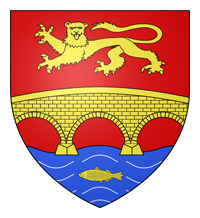 |
Welcome to Pont-d'Ouilly |


History - Pont-d'Ouilly
Geographical situation, Roads and ways, The bridge, Religious buildings, Trade and Industry, Public and private services, Schools
Geographical situation
The village is located on the RD511, 18 km from the west of Falaise, and 12 km from the east of Conde-sur-Noireau.
The surface of the commune is 1.950 ha 17 a 78 ca for a total perimeter of approximately 33,1 km.
The Orne departement is bordering on our commune on 8,8 km.
The highest area is at an altitude of 252 meters (Mont-Pitois), and the lowest one at 42 meters (Orne river in the north).
Roads and ways
On the map drawn by M. Cassini, three ways are represented on the territory of our commune.
The first one, knowed as the "Grand Chemin de Bretagne", is issued from Falaise through the borough of Ouilly-le-Basset and joins the Orne river by the "Chemin du Roi";
after the bridge, it joins the borough of Saint-Marc-d'Ouilly by the "Chemin de la Butte" and continues towards Le Fresne and Pontécoulant.
The second one, starts with the bottom of La Valette to join Saint-Christophe, then Donnay and Cesny-Bois-Halbout.
The third and last one, starts from the Haut-d'Ouilly, passes through the Orne river at Rouilly pontoon and joins Condé through Berjou.
Other main ways joins Pont-d'Ouilly which is thus an important point to pass through the Orne river.
The bridge
Until the middle of the XIXth century, the bridge has eight arches.
A cross is in the middle, and is the limit both between the two parishes and between the two communes of Ouilly-le-Basset and of Saint-Marc-d'Ouilly.
A new bridge is built from September 22, 1849 to May 14, 1851. Tuesday October 5, 1852, an important rising of the Orne river demolishes a part of the new bridge.
A fifth arch is built after this accident.
During June and July 1944, the bridge is bombarded many times; it is finally destroyed on Saturday August 12, 1944.
On Saturday 19, the English troops builds a Bailey bridge baptized Jacqueline Bridge.
The building of the actual bridge begins in June 1947 and, May 17, 1948, M. Marcel Guyon, mayor of our very new commune, inaugurates it officially.
Religious buildings
Pont-d'Ouilly offers its visitors four religious buildings :
- Sainte-Therese church in the centre, was built in 1925 on the very grounds where stood a chapel since the 12th century; the architect in charge for the new church was Mr Pierre Chirol; it was blessed on July 11, 1926 and consecrated on October 16, 1932; it is the first church dedicated to Sainte-Therese.
- Saint-Jean-Baptiste church in Ouilly-le-Basset, replaces, since 1860, an old norman chapel; the stained glass conjuring up the seven sacraments dated 1961 are made by Mr Bernard Legrand.
- Saint-Medard church in Saint-Marc-d'Ouilly, dates back to 1889 and replaces an older one from the 12th century; inside, a statue made of solid elm shows Saint-Roch; it is carried in procession fro the yearly "Grand Pardon".
- Saint-Roch chapel in Saint-Marc-d'Ouilly, built in the late 16th century, has been totaly restored in 1933; inside, eight marvellous frescos by Mr Maurice Le Scouezec, show the life of Saint-Roch; the two frescos, one on the chevet, one in the back, dated 1984 are by the polish artist Marek Sobczyk; a pilgrimage takes place here every year on the sunday after the 15th August; it is the "Grand Pardon of Saint-Roch".
Trade and Industry
The old Market, burnt in 1824 and rebuilt in 1826, was until the middle of the 20th century a place of important exchange for all the area :
butcheries, grains, poultries, butter, game and other food products of first need were proposed there.
Crossing point above the Orne river, Pont-d'Ouilly also had for a long time the advantage of a prospering commercial activity : in 1901, at least 75 trades were present.
During the 19th century, our old communes benefited from the regional developpement of the cotton industry.
Several factorys site was thus exploited : La Pautiche, Saint-Christophe, Le Moulin-Neuf and two establishments located on both sides of the bridge on the left bank of the Orne river.
Public and private services
- Railroad : the rail line from Berjou-Pont-d'Ouilly to Caen was open on Mai 15, 1873; that from Falaise to Berjou on Avril 15, 1874, its closure took place on November 3, 1969.
- Notary's office : always located on the right bank of the Orne river, it is the heritage of the Tabellionnages which existed until the 18th century.
- Post Office : the Post with the horses was created in January 1818; the Post Office took place three years later, in July 1821. The Small-Figure obliteration was 2508, the Large-Figure one was 2942. In 1881, after the startup of the Telegraph, the post office was transferred on the road from Pont-des-Vers. The Telephone arrived to Pont-d'Ouilly in 1905 thanks to a private financing.
- Police : the first detachment was created to Ouilly-le-Basset on August 25, 1831. After the destruction of 1944, the brigade was rebuilt on the road to Caen and lived in since December 15, 1961.
- Firemen : from the beginning of the 19th century, the Garde Nationale included a subdivision of firemen. However, it was only on February 25, 1892 that the company was officially created.
Schools
In 1715, a college of Jesuits existed to Pont-d'Ouilly. The school of Ouilly-le-Basset was built in 1852, that of Saint-Marc-d'Ouilly in 1877. In the village of Pont-d'Ouilly, the school built in 1883 was destroyed on August 16, 1994. The first stone of the current school complex was posed on April 12, 1953.

